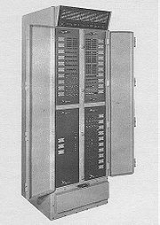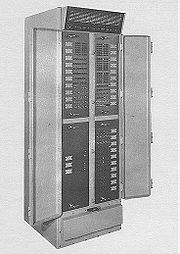
UNIVAC 418
Encyclopedia
The UNIVAC 418 was a transistorized
, 18-bit
word core memory machine made by Sperry Univac. The name came from its 4 microsecond memory cycle time and 18-bit word. The assembly language
for this class of computers was TRIM III and ART418.
Over the three different models, more than 392 systems were manufactured. It evolved from the Control Unit Tester (CUT), a device used in the factory to test peripherals for larger systems.
Numbers were represented in ones' complement, single and double precision. The TRIM assembly source code
used octal
numbers as opposed to more common hexadecimal
because the 18-bit words are evenly divisible by 3, but not by 4.
The machine had the following addressable registers:
All register values were displayed in real time on the front panel of the computer in binary
, with the ability of the user to enter new values via push button
(a function that was safe to perform only when the computer was not in run mode).
 The 418-I was also available in a militarized version as the UNIVAC 1218. It was almost 6 feet tall and weighted 775 lb. It required both 115VAC, 1-phase, 60 Hz and 115VAC, 3-phase, 400 Hz power.
The 418-I was also available in a militarized version as the UNIVAC 1218. It was almost 6 feet tall and weighted 775 lb. It required both 115VAC, 1-phase, 60 Hz and 115VAC, 3-phase, 400 Hz power.
) words of memory. Memory cycle time was reduced to 2 microseconds. The militarized version was called the UNIVAC 1219 (known as the "Mk 152 Fire Control Computer.") It was part of the Navy's Mk 76 missile fire control system, used to control the AN/SPG-55
radar system.
The 418-III had two unique hardware features which enabled it to handle continuously high speed serial character streams. One was called the buffer overflow interrupt and the other hardware buffer chaining.
By the 1990s, all the 418 hardware was gone, but the California Department of Water Resources
was still running 418 emulation on a UNIVAC 1100/60
.
Transistor computer
A transistor computer is a computer which uses discrete transistors instead of vacuum tubes. The "first generation" of electronic computers used vacuum tubes, which generated large amounts of heat, were bulky, and were unreliable. A "second generation" of computers, through the late 1950s and...
, 18-bit
18-bit
18 binary digits have unique combinations.-Example 18-bit computer architectures:* Possibly the most well-known 18-bit computer architectures are the PDP-1, PDP-4, PDP-7, PDP-9 and PDP-15 minicomputers produced by Digital Equipment Corporation from 1960 to 1975.* UNIVAC produced a number of...
word core memory machine made by Sperry Univac. The name came from its 4 microsecond memory cycle time and 18-bit word. The assembly language
Assembly language
An assembly language is a low-level programming language for computers, microprocessors, microcontrollers, and other programmable devices. It implements a symbolic representation of the machine codes and other constants needed to program a given CPU architecture...
for this class of computers was TRIM III and ART418.
Over the three different models, more than 392 systems were manufactured. It evolved from the Control Unit Tester (CUT), a device used in the factory to test peripherals for larger systems.
Architecture
The instruction word had three formats:- Format I - common Load, Store, and Arithmetic operations
- f - Function code (6 bits)
- u - Operand address (12 bits)
- Format II - Constant arithmetic and BooleanBoolean logicBoolean algebra is a logical calculus of truth values, developed by George Boole in the 1840s. It resembles the algebra of real numbers, but with the numeric operations of multiplication xy, addition x + y, and negation −x replaced by the respective logical operations of...
functions- f - Function code (6 bits)
- z - Operand address or value (12 bits)
- Format III - Input/Output
- f - Function code (6 bits)
- m - Minor function code (6 bits)
- k - Designator (6 bits) used for channel number, shift count, etc.
Numbers were represented in ones' complement, single and double precision. The TRIM assembly source code
Source code
In computer science, source code is text written using the format and syntax of the programming language that it is being written in. Such a language is specially designed to facilitate the work of computer programmers, who specify the actions to be performed by a computer mostly by writing source...
used octal
Octal
The octal numeral system, or oct for short, is the base-8 number system, and uses the digits 0 to 7. Numerals can be made from binary numerals by grouping consecutive binary digits into groups of three...
numbers as opposed to more common hexadecimal
Hexadecimal
In mathematics and computer science, hexadecimal is a positional numeral system with a radix, or base, of 16. It uses sixteen distinct symbols, most often the symbols 0–9 to represent values zero to nine, and A, B, C, D, E, F to represent values ten to fifteen...
because the 18-bit words are evenly divisible by 3, but not by 4.
The machine had the following addressable registers:
- A - Register (Double precision AccumulatorAccumulator (computing)In a computer's central processing unit , an accumulator is a register in which intermediate arithmetic and logic results are stored. Without a register like an accumulator, it would be necessary to write the result of each calculation to main memory, perhaps only to be read right back again for...
, 36 bits) composed of:- AU - Register (Upper Accumulator, 18 bits)
- AL - Register (Lower Accumulator, 18 bits)
- ICR - Register (Index Control Register, 3 bits), also designated the "B-register"
- SR - Register ("Special Register", 4 bits), a paging register allowing direct access to memory banks other than the executing (P register) bank
- P - Register (Program address, 15 bits)
All register values were displayed in real time on the front panel of the computer in binary
Binary numeral system
The binary numeral system, or base-2 number system, represents numeric values using two symbols, 0 and 1. More specifically, the usual base-2 system is a positional notation with a radix of 2...
, with the ability of the user to enter new values via push button
Button (computing)
In computing, a button is a user interface element that provides the user a simple way to trigger an event, like searching for a query at a search engine, or to interact with dialog boxes, like confirming an action.-Description:A typical button is a rectangle or rounded rectangle, wider than it is...
(a function that was safe to perform only when the computer was not in run mode).
UNIVAC 418-I
The first UNIVAC 418-I was delivered in June 1963. It was available with 4,096 to 16,384 words of memory.UNIVAC 1218 Military Computer

| Basic System/Component | Purchase Price |
|---|---|
| Minimum 1218 Computer: 4,096 word memory, 4 I/0 | $ 96,000 |
| Most common 1218 Computer: 16,384 word memory, 8 I/0 | $ 127,000 |
| Militarized Mag Tape System (2 handlers) | 80,500 |
| Paper Tape Subsystem including keyboard & printer | 25,000 |
| High speed printer system | 77,500 |
| 80 column card system | 83,250 |
| —————— | |
| Grand Total Minimum 1218 Computer System | $ 362,250 |
| Grand Total Most common 1218 Computer System | $ 393,250 |
UNIVAC 418-II
The first UNIVAC 418-II was delivered in November 1964. It was available with 4,096 to 65,536 (18-bitBit
A bit is the basic unit of information in computing and telecommunications; it is the amount of information stored by a digital device or other physical system that exists in one of two possible distinct states...
) words of memory. Memory cycle time was reduced to 2 microseconds. The militarized version was called the UNIVAC 1219 (known as the "Mk 152 Fire Control Computer.") It was part of the Navy's Mk 76 missile fire control system, used to control the AN/SPG-55
AN/SPG-55
The AN/SPG-55 was a tracking / illumination radar for Terrier and RIM-67 Standard missiles . It was used for target tracking and Surface-to-air missile guidance on numerous ships including s,s, s and Farragut class destroyers. It was also used on the nuclear powered single units , and...
radar system.
UNIVAC 418-III
The first UNIVAC 418-III was delivered in 1969. It was available with 32,768 to 131,072 words of memory. Memory cycle time was reduced to 750 nanoseconds. New instructions were added for floating-point arithmetic, binary-to-decimal and decimal-to-binary conversions, and block transfers up to 64 words. The SR register was expanded to 6 bits.The 418-III had two unique hardware features which enabled it to handle continuously high speed serial character streams. One was called the buffer overflow interrupt and the other hardware buffer chaining.
By the 1990s, all the 418 hardware was gone, but the California Department of Water Resources
California Department of Water Resources
The California Department of Water Resources , is a department within the California Natural Resources Agency. The Department of Water Resources is responsible for the State of California's management and regulation of water usage...
was still running 418 emulation on a UNIVAC 1100/60
UNIVAC 1100/60
The UNIVAC 1100/60, introduced in 1979, continued the venerable UNIVAC 1100 series first introduced in 1962 with the UNIVAC 1107. It was the first 1100 series machine introduced under the Sperry Corporation name....
.
External links
- The UNIVAC 418 Computer Unisys History Newsletter Volume 4, Number 2 August 2000 by George Gray
- UNIVAC 418 documents on bitsavers.org
- UNIVAC 1218 Military Computer 1964 BRL report from Aberdeen Proving Grounds
- The Automated Weather Network The USAF creates a real-time network of UNIVAC 418s
- 18-bit Computers - Computer Unit Tester, 1218 (CP-789), AN/UYK-5 Moonbeam, 1219B-CP-848/UYK , CP-914, ILAAS, 1819, AN/UYK-11(V)
- Article about the Univac 1219 and it's use in the Navy's Tartar Missile System
- Design of the real-time executive for the Univac 418 system

